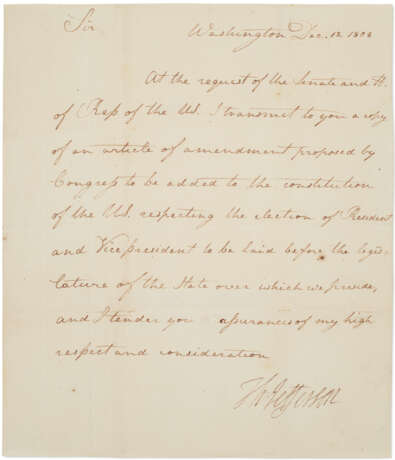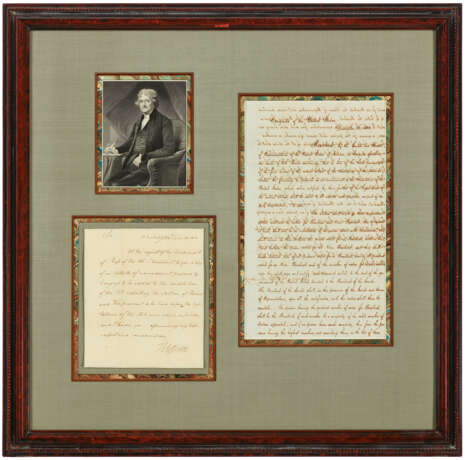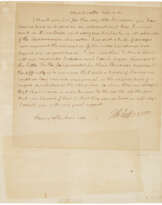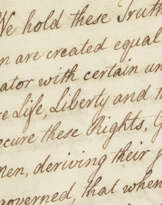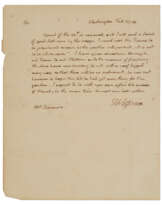ID 1362202
Lot 659 | Transmitting a manuscript copy of the Twelfth Amendment
Estimate value
$ 70 000 – 100 000
Thomas Jefferson, 13 December 1804
TWELFTH AMENDMENT – JEFFERSON, Thomas (1743-1826). Letter signed ("Th: Jefferson") as President, to an unnamed correspondent, Washington, 13 December 1804. [With:] OTIS, Samuel Allyne (1740-1814). Manuscript document signed ("Sam: A. Otis") as Secretary of the Senate, [Washington,] 12 December 1803.
Letter: 1 page, 218 x 187mm (mild creasing). Hinged to a mat; Document: two pages, bifolium, 378 x 224 (light toning and ink show though from verso). Encapsulated. Both framed together with a portrait of Jefferson.
Thomas Jefferson transmits an official clerical copy of the Twelfth Amendment of the Constitution for ratification. In an elegantly penned circular letter, Thomas Jefferson transmits a manuscript copy of the twelfth amendment of the Constitution: "At the request of the Senate and H. of Rep. of the U. S. I transmit to you a copy of an...amendment proposed by Congress to be added to the Constitution of the U. S., respecting the election of President and Vice President, to be laid before the legislature of the State...and I tender you assurances of my high respect and consideration." Jefferson's letter is accompanied by an official copy of the Twelfth Amendment, accomplished in a clerical hand and attested by Samuel Allyne Otis, Secretary of the Senate.
Under the original provisions of Article 2, Section 1 of the Constitution, members of the Electoral College were to name two candidates for President on their ballots, and when Congress counted the votes the winner became President while the runner-up became Vice-president. The framers of the Constituion, who demonstrated an antipathy toward factionalism and party politics, did not envision the flaw in the system until the election of 1796 which pitted John Adams against Thomas Jefferson, who by then had become political adversaries over the contentious issue of how best to handle relations with revolutionary France. While both Adams and Jefferson ostensibly had politically-aligned running mates in the persons of Thomas Pinckney and Aaron Burr, the Electoral College thwarted these plans by scattering their second votes among several candidates. In the end, Adams won the most votes (71) and Jefferson came in second with 68. Even before the pair were inaugurated, Representative William Smith of South Carolina offered a resolution for a constitutional amendment that would require each elector to specify their votes for president and vice president, but no action was taken.
Mindful of the awkward and borderline-dysfunctional situation in the executive branch, both the Federalists and Democratic-Republicans resolved to nominate separate candidates for President and Vice President in the election of 1800. The Federalists nominated Adams the incumbent for president and Charles C. Pinckney for vice president, while the opposition chose Jefferson and Burr for their ticket. However there was no mechanism to coordinate which Elector would abstain from voting in order to ensure that Jefferson was elected president. In the end, none of the Democratic-Republican electors did so, and both Jefferson and Burr received 73 votes which threw the election into the House of Representatives. Die-hard Federalists, who considered Burr the less dangerous of the two attempted to push Burr's election as President. Adding to the impasse, Burr refused to concede. "There was grave uncertainty and at least a threat of chaos. There was even talk of Civil War" (Dumas Malone, Jefferson the President, First Term, p.6). No fewer than 33 ballots were taken between 11 and 17 February 1801, all deadlocked. Finally Alexander Hamilton solicited the necessary support for Jefferson to break the tie.
The new amendment spelled out in the most precise terms the electoral procedure for choosing the President and Vice-President, stipulating that, "The Electors shall meet in their respective states, and vote by ballot for President and Vice-President...; they shall name in their ballots the person voted for as President, and in distinct ballots the person voted for as Vice-President, and they shall make distinct lists of all persons voted for as President, and of all persons voted for as Vice-President..." (MacDonald, ed., Select Documents Illustrative of the History of the United States, 1968, pp. 43-44). Opposition was non-existent: the states ratified it on 27 July 1804.
Extremely Rare. Although several examples of Jefferson's letter of transmittal have appeared at auction over the past century (possibly as many as seven), only one other official manuscript copy of Amendment XII has ever been sold (Sotheby's, 23 November 2021, lot 70, $403,200). That copy, dated Washington, 9 December 1803, was additionally signed by John Beckley, Clerk of the House of Representatives, but like the present version, was intended to be presented to the states for consideration and ratification. A superb pair of documents documenting the correction of one of the original flaws of the Constitution.
| Artist: | Thomas Jefferson (1743 - 1826) |
|---|---|
| Category: | Services |
| Auction house category: | Letters, documents and manuscripts, Books and manuscripts |
| Artist: | Thomas Jefferson (1743 - 1826) |
|---|---|
| Category: | Services |
| Auction house category: | Letters, documents and manuscripts, Books and manuscripts |
| Address of auction |
CHRISTIE'S 20 Rockefeller Plaza 10020 New York USA | ||||||||||||||
|---|---|---|---|---|---|---|---|---|---|---|---|---|---|---|---|
| Preview |
| ||||||||||||||
| Phone | +1 212 636 2000 | ||||||||||||||
| Fax | +1 212 636 4930 | ||||||||||||||
| Conditions of purchase | Conditions of purchase | ||||||||||||||
| Shipping |
Postal service Courier service pickup by yourself | ||||||||||||||
| Payment methods |
Wire Transfer | ||||||||||||||
| Business hours | Business hours
|
